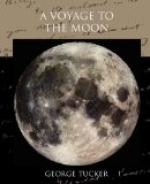After a few hours, we were so near the moon that every object was seen in our glass, as distinctly as the shells or marine plants through a piece of shallow sea-water, though the eye could take in but a small part of her surface, and the horizon, which bounded our view, was rapidly contracting. On letting the air escape from our machine, it did not now rush out with the same violence as before, which showed that we were within the moon’s atmosphere. This, as well as ridding ourselves of the metal balls, aided in checking our progress. By and bye we were within a few miles of the highest mountains, when we threw down so much of our ballast, that we soon appeared almost stationary. The Brahmin remarked, that he should avail himself of the currents of air we might meet with, to select a favourable place for landing, though we were necessarily attracted towards the same region, in consequence of the same half of the moon’s surface being always turned towards the earth.
“In our second voyage,” said he, “we were glad to get foothold any where; for, not having lightened our machine sufficiently, we came down, with a considerable concussion, on a barren field, remote from any human habitation, and suffered more from hunger and cold, for nearly three days, than we had done from the perils and privations of the voyage. The next time we aimed at landing near the town of Alamatua, which stands, as you may see, a little to the right of us, upon an island in a lake, and looks like an emerald set in silver. We came down very gently, it is true, but we struck one of the numerous boats which ply around the island, and had nearly occasioned the loss of our lives, as well as of theirs. In our last voyage we were every way fortunate. The first part of the moon we approached, was a level plain, of great extent, divided into corn-fields, on which, having lowered our grapnel, we drew ourselves down without difficulty.
“We must now,” continued he, “look out for some cultivated field, in one of the valleys we are approaching, where we may rely on being not far from some human abode, and on escaping the perils of rocks, trees, and buildings.”
While the Brahmin was speaking, a gentle breeze arose, as appeared by our horizontal motion, which wafted us at the rate of about ten miles an hour, in succession, over a ridge of mountains, a lake, a thick wood, and a second lake, until at length we reached a cultivated region, recognised by the Brahmin as the country of the Morosofs, the place we were most anxious to reach.
“Let off two of the balls of lead to the earth,” said he. I did so, and we descended rapidly. When we were sufficiently near the ground to see that it was a fit place for landing, we opened the door, and found the air of the moon inconceivably sweet and refreshing. We now loosed one of the lower balls, and somewhat checked our descent. In a few minutes more, however, we were within twenty yards of the ground, when we let go the largest ball of




